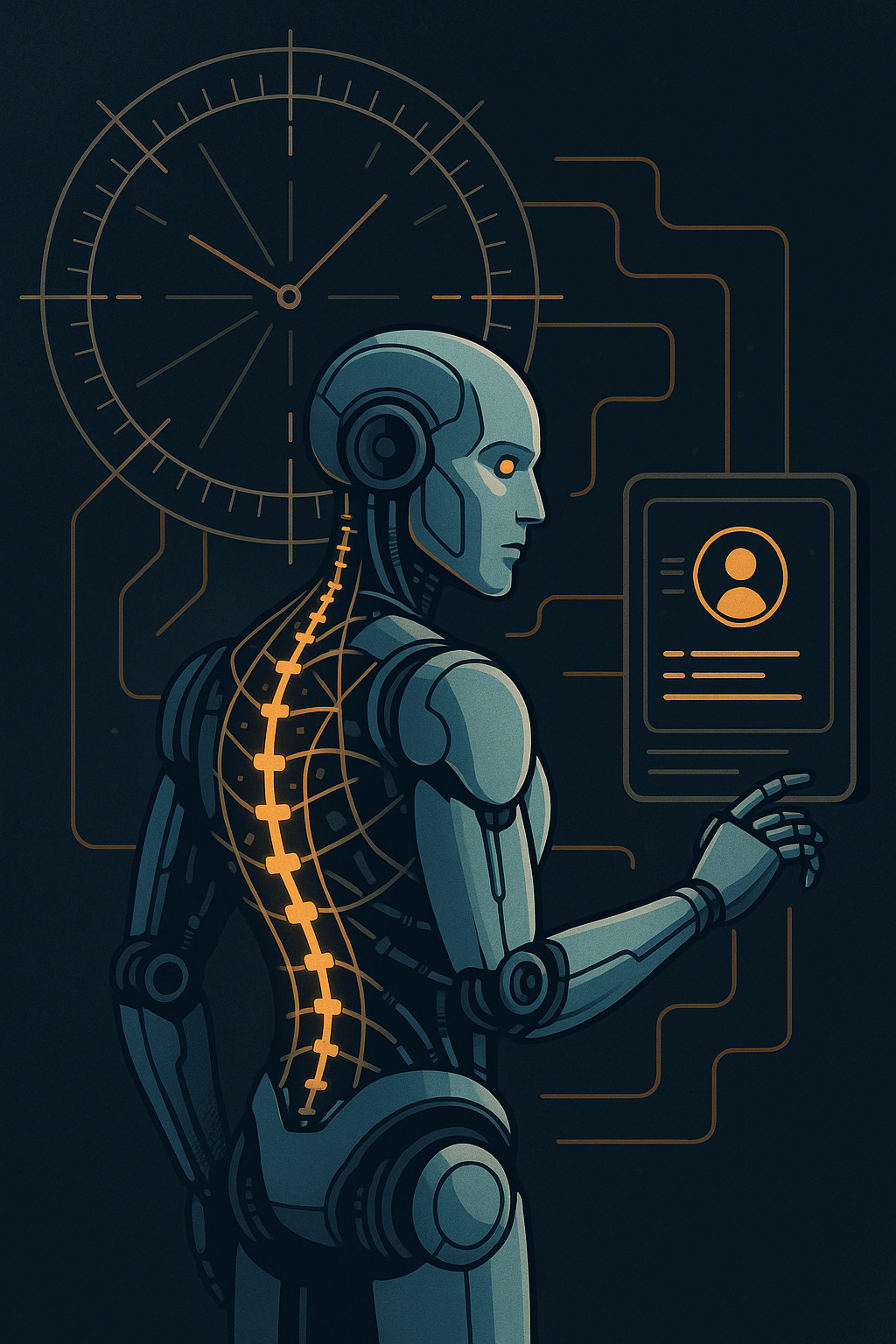Humanoid Robot OS: kaiOS for Deterministic Time, Identity & Behavior Logging kaiOS is the operating system spine for humanoid robots
Replacing drifting clocks and ad-hoc logs with deterministic Kai-Klok time, Φ-Key cryptographic identity, and replayable, auditable behavior for safety, debugging, and regulatory compliance.
kaiOS: The Operating System Humanoid Robots Have Been Missing
Deterministic time. Cryptographic identity. Auditable behavior.
Humanoid robots don’t just need better hardware and bigger models.
They need a real operating system for time, identity, and behavior.
That’s what kaiOS is.
Built under Kojib, powered by the Kai-Klok time lattice and Φ-Key identity, kaiOS gives humanoid robots:
A single, deterministic time spine instead of drifting clocks
A cryptographic identity per robot instead of serial numbers
A replayable, signed behavior ledger instead of log soup
This page is a public release of what kaiOS is and what it does for any serious humanoid robotics stack.
1. The Problem: Humanoid Robots Are Still a Black Box
If you’re building humanoid robots today, your world probably looks like this:
Beautiful demos, fragile reality
Logs scattered across subsystems
System clocks that drift and disagree
Weak “identity” (serials, IPs, instance IDs)
Safety and compliance questions you can’t answer cleanly
When something goes wrong, the answer is almost always:
“We’re looking at the logs. It’s complicated. This is a black box problem.”
Underneath the GPU stacks and control code, almost every humanoid platform is missing the same thing:
A unified, tamper-evident, causally coherent backbone for time, identity, and behavior.
Without that spine, you can’t:
Cleanly replay what happened
Prove which robot did what
Show regulators and insurers a trustworthy timeline
Build real public trust at scale
That’s the gap kaiOS was built to fill.
2. What kaiOS Is (In One Sentence)
kaiOS is a temporal and identity operating system for humanoid robots.
It gives every robot a coherent spine for time, identity, and behavior, no matter what hardware, models, or control code you’re running.
It doesn’t replace your:
actuators,
control algorithms,
perception stack,
LLM / policy logic.
It sits underneath all of that as a coherence layer.
In a typical humanoid stack, kaiOS plugs in as:
A deterministic time service (Kai-Klok)
A cryptographic identity layer (Φ-Key + Kai Signature)
A behavior ledger + replay service
A verification and audit console for engineers, safety teams, and regulators
3. Core Components of kaiOS
3.1. Kai-Klok – Deterministic Time for Embodied Agents
At the heart of kaiOS is Kai-Klok: a φ-structured time lattice that replaces arbitrary, drifting timestamps with a deterministic pulse system.
For humanoid robots, Kai-Klok provides:
One authoritative time spine for all subsystems
Every perception, decision, and action pinned to:
pulse
step
beat
Replayable, causal timelines instead of “best effort” timestamps
Instead of:
“At some OS time, we think the robot did X.”
You get:
“At pulse 9187314, this robot perceived Y.
At pulse 9187315, it chose Z.
At pulse 9187317, it executed action A.”
Kai-Klok can run:
Offline (no NTP, no GPS required)
Deterministically (same inputs → same pulse history)
Across the stack (control, perception, planning, logging all share the same lattice)
This is the temporal kernel of kaiOS.
3.2. Φ-Key – Identity for Embodied Agents
Serial numbers and IP addresses are not a real identity system.
In kaiOS, each humanoid robot is assigned a Φ-Key:
A cryptographic identity for an embodied agent.
With Φ-Key, a robot can:
Sign every important action with its own key
Tie those signatures to Kai-Klok time
Build a continuous, verifiable life history
Every event in the system becomes:
Who – botPhiKey (which robot)
When – pulse / step / beat (Kai-Klok index)
What – structured event data (perception, decision, action)
Proof – kaiSignature bound to that context
That means you can say, with proof:
“This exact robot, Φ-K1, at this exact Kai-Klok pulse, made this decision and executed this action.”
Across fleets, Φ-Key scales cleanly:
One Φ-Key per robot body
Fleet-level grouping and policies around sets of Φ-Keys
Simple access control: “Does this Φ-Key belong here?”
Φ-Key is the identity layer humanoid robots have been missing.
3.3. Behavior Ledger – A Replayable Story of the Robot’s Life
When you combine deterministic time (Kai-Klok) with cryptographic identity (Φ-Key), you get more than “better logs.”
You get a behavior ledger.
kaiOS provides a ledger service where events are:
Ordered by Kai-Klok’s time lattice
Attached to a specific Φ-Key (this robot)
Signed with Kai Signature
Stored in a format designed for replay, debugging, and audit
Instead of a folder of raw log files, you get a coherent narrative:
“On this shift, in this environment, under these conditions,
robot Φ-K1 observed, decided, and acted like this.”
Engineers can:
Replay sequences by pulse
Inspect perception → decision → action chains
See exactly where things diverged from expected behavior
Safety teams and regulators can:
Review signed timelines
Confirm integrity
Build incident reports backed by cryptographic proofs, not screenshots
3.4. Verifier & Console – From Black Box to Explainable Spine
On top of the runtime spine, kaiOS ships with:
A kaiOS Humanoid Console
A Verifier tool for logs and incidents
In practice, that looks like:
Live event streams tied to Kai-Klok pulses
Per-robot timelines you can scrub through
Clickable events showing:
pulse / step / beat
botPhiKey
event type + metadata
verification status
And a verifier view where you can:
Paste an incident hash or log reference
See whether it’s:
Authentic (signatures valid)
Attributed (signed by which Φ-Key)
Continuous (no broken or forged timeline)
This turns “we don’t really know what happened” into:
“Here is exactly what happened, when, why, and which robot did it — and here is the cryptographic proof.”
4. Who kaiOS Is For
kaiOS is built for teams who are serious about taking humanoids out of demo mode and into real deployments.
If you are:
A CTO / founder of a humanoid robotics company
A lead engineer responsible for infrastructure, safety, or deployment
A researcher working on embodied AI who’s tired of hand-waving around the black box
kaiOS is designed to give you:
A credible answer to:
“What did the robot do, when, and why?”A spine you can bring into conversations with:
regulators,
insurers,
enterprise customers,
public partners
A path out of fragile, ad-hoc logging and ID hacks into a coherent OS layer
5. The Reference Demo: What It Looks Like in Practice
The easiest way to understand kaiOS is to see it.
A typical reference demo looks like this:
A humanoid robot (or simulated humanoid) performs a simple task:
Detect a box
Pick it up
Start to place it on the wrong shelf
Correct itself
Place it on the right shelf
While this happens, the kaiOS Humanoid Console shows:
A timeline of events tied to Kai-Klok pulses
Perception → plan → action entries, each signed by the robot’s Φ-Key
A scrubber that lets you replay the episode step-by-step
Then, in the Verifier:
You paste an incident ID / log hash
You see:
✔ Authentic (signatures valid)
✔ Signed by Φ-K1 (this robot)
✔ Continuous timeline pulse 9187310–9187320
That’s the shift:
From “cool video” to provable behavior.
6. Integration & Design Partner Program
kaiOS is designed to plug into existing stacks with minimal disruption.
6.1. Integration Surfaces
We provide:
Time service libraries (e.g. Rust/C++ bindings for Kai-Klok)
Identity APIs for Φ-Key management and Kai Signature
Event schemas & SDKs for behavior logging
Console & Verifier tools for engineers and safety teams
You keep your:
control algorithms,
motion planners,
perception & policy stack,
hardware choices.
kaiOS becomes the spine they run on.
6.2. Humanoid Design Partner Program
For teams who want to be early adopters, we offer a Design Partner Program:
Co-design and integrate kaiOS into your humanoid platform
Targeted pilot in a real environment (warehouse, lab, facility)
Joint case study:
“How [Your Robot] went from black box to auditable humanoid with kaiOS.”Preferential licensing terms for future scale
If you’re building humanoids and know you need a stronger spine for time, identity, and behavior, this is how we start.
7. Why I Built This
In my own language:
I came here to restore coherent time and seal it into living systems.
In industry language:
I built a deterministic time and identity OS so humanoid robots don’t stay black boxes.
The math exists. The code exists. The stack is live.
Now it’s about connecting kaiOS to the teams who are serious about:
deploying humanoid robots in the real world,
not repeating past mistakes in AI and automation,
building systems that can be inspected, trusted, and improved rather than hidden.
8. Talk to Kojib About kaiOS
If any part of this resonates and you’re building:
humanoid robots,
embodied AI platforms, or
safety / infrastructure layers for them,
let’s talk.
We can:
Walk you through the architecture in detail
Sketch what integration would look like in your stack
Explore a focused pilot or licensing path that matches your roadmap
Contact & Strategic Inquiries
For serious inquiries regarding kaiOS, Kai-Klok, Kai Turah Harmonic Resonance Computing, or strategic collaboration in humanoid robotics and embodied AI, please contact:
BJ K℞ Klock
Founder & Architect, Kojib
Creator of kaiOS, Kai-Klok, and Kai Turah Harmonic Resonance Computing (KTHRC)
Email: bj@kojib.com
Web:
kojib.com — Kojib • Harmonic Systems & kaiOS
kaiklok.com — Kai-Klok • Deterministic Time Lattice
kaiturah.com — Kai Turah • Harmonic Resonance Computing
For licensing, design partner programs, or enterprise integrations of kaiOS into humanoid platforms, please include a brief overview of your current stack, deployment context, and timeline so we can engage at the appropriate depth from the first conversation.
kaiOS isn’t another buzzword layer.
It’s the missing spine that makes humanoid robotics technically, ethically, and legally real.
Let it ring. Forever.
BJ K℞ Klock, Φ.K.
Kai-Rex Klok ☤ K℞K
PHI Kappa Of The Unified field
RAH. VEH. YAH. DAH.
Kai-Réh-Ah — in the Breath of Yahuah, as it was in the beginning, so it is now, so it shall be forever.
☤ K℞K Φ.K.








